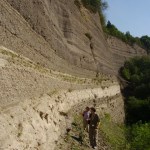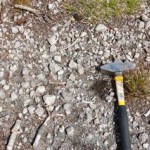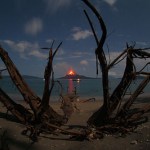volcanoes in the media
We've arrived at Friday. The local time is 8:45 A.M. Set your watches accordingly.
Batur, Indonesia
Some news!
More evacuations have been authorized near Mayon as the volcano continues to show signs of significant eruption. Activity has quieted some since Tuesday's explosion, but PHIVOLC still expresses concern that an eruption in impending within weeks. I'll also add a link to this story on Mayon, not because it has new news, but because it has quiet possibly the worst accompanying photo for this story I've seen so far. I mean, really, couldn't you have found some stock picture of Mayon…
Geologic and structural map showing the extent of the Campi Flegrei caldera on the north of the Bay of Naples, Italy. Image courtesy of INGV.
One of the writing assignments I always enjoyed in high school was the "compare and contrast". You could sit back and look for stylistic differences between writers and texts - potentially offering signs about the nature of the writers motivations.
I still find it fun - case in point, two article I read about the research drilling that is about to start at the Campei Flegrei in Italy. The Campei Flegrei is a large caldera system that most recently…
It seems like I've been stepping on a lot of people's toes lately, so in an effort to foster more camaraderie and less belligerence between the "old media" (this is not derogatory, but rather refers to anything pre-internet news source or classic journalistic source) and "new media" (this includes internet-era news sources, bloggers and the like), I'd like to put down my thoughts on the state of science journalism on the internet today.
I do not think all media is bad at science. There are a multitude of great science sources out there that handle the issues quite well, mostly associated…
Lava flows from the 2005 Mando Hararo eruption in Ethiopia.
Alright, I had been attempting to ignore this story because it was, well, a little uninteresting at first, but it apparently has legs so I will tackle it.
Slashdot has a post proclaiming:'Volcanic activity may split the African continent in two, creating a new ocean, say experts. This is due to a recent geological crack which has appeared in northeastern Ethiopia.'
OK. Where do I start?
This is based on a recent study published in Geophysical Research Lettersthat found that the recent volcanism in Ethiopia is related to the active…
There have been a number of articles floating around the popular press for the last week that I thought I would touch on briefly ... always fun to decipher the real news from the hype.
Active fumaroles on Datun Mountain in Taipei.
An article out of the Taipei Times suggests that the city of Taipei in Taiwan is in great peril from Datun Mountain/volcano. The volcano, which was previously thought to have erupted ~200,000 years ago is now thought to have erupted only 5,000 years ago. That 195,000 years really does make a difference in terms of worrying about potential future eruptions, but there…
News to finish up your week:
Summit area of Hualalai in Hawai'i
Another day, another "threat" of volcanic eruption in Australia. I'm impressed with the abject fear Aussies seem to have for this perceived increased threat of an eruption - or at least what the press wants you to believe. This time, watch out near Bundaberg, Townsville and Cooktown in southeast Queensland!
In more press-related exaggeration, the Siberian Traps - a flood basalt eruption from, well, thousands of rift/vents in Siberia - is boiled down to being one Siberian volcano by the Telegraph. Dr. Mark Sephton of the Imperial…
A bit of news for your last Monday in September:
Pumice deposits from the ~13,000 year old Laacher See eruption. Image by Erik Klemetti, taken in August 2007.
More press for Dr. Joyce and his campaign to make the people of Australia terrified that volcanoes will destroy them. He warns of "new volcanoes" springing up in the Ballarat region to the northwest of Melbourne (which, incidentally, is where I pointed out might be the most likely place for future volcanism). Yes, sure, we should expect that a new, unknown scoria cone may form in the Newer Volcanic Province - I mean, that is what…
Some brief tidbits for your Wednesday:
The view of Mt. Saint Helens from the Johnston Ridge Observatory.
There is a decent article about research being done at a dissected caldera system in the Italian Alps' Sesia Valley. The caldera in question is the Permian in age (248-298 million years old) so don't expect to find it in the GVP database, but the outcrops of this ancient caldera are especially well exposed, allowing for a cross section of volcano and plutonic rocks across 25 km of crustal depth (all of which is now at the surface thanks to hundreds of millions years of tectonics). It does…
There are a couple article out today concerning volcanoes and the economy, one on the plus side, one on the minus side.
Volcano Buono in Italy near Naples.
First off, nothing like volcanism to get me stoked for buying stuff, eh? Actually, I have to admit, the Volcano Buono mall (yes, mall) in Italy near Naples (and yes, near Vesuvius) is one of the rather more attractive malls I've seen in a long time (above). It is designed to look like a volcano - I suppose it looks most like a monogenetic scoria cone, a little out of place for that part of Italy - but its design was based on trying use…
Lets get right to it!
"Manmade volcanoes": can they solve global warming?
It does indeed seem that something is happening beneath Kanlaon in the Philippines. PHIVOLCS reports that the volcano experienced 257 volcanic earthquakes from August 23 to September 1, well above the usually "background" level of ~20-30 a week. Most of this seismicity is centered on the northwest slope of the volcano, suggesting that if magma is moving, it is moving up under this side of the system. However, the seismicity doesn't necessarily have to be magma moving up to erupt. It could very easily be moving up in the…
The move is complete (finally) ... so maybe I can settle down a bit, right? Right?
The world's deadliest volcano?
Anyway, a few things I stumbled across this week:
Forbes Traveler.com has a list boldly titled "World's Deadliest Volcanoes", which more or less is a slideshow of nice volcano pictures and some dubious ranking - mostly based on death toll (and cribbing a bit from IAVCEI's "Decade Volcanoes"). Of course, I find it amusing that they made a list of "deadliest volcanoes" and then proceed to tell people (read "tourists") what to do near the so-called "deadly" volcanoes. I suppose it is…
First day of class! As you might imagine, I'm a little scattered (well, with classes and the fact that we bought a house over the weekend. You know, just that).
The Tavurvur Crater at Rabaul erupting in 1994.
News!
The Examiner.com (SF) has a slideshow and brief article on the current excavations of ruins buried by the Santorini/Minoan eruption that occurred ~3950 years ago. The eruption wiped out much of the island of Crete in the Aegean Sea, but whether there was anyone actually still living on the island when it happened is still a mystery. It seems that most of the Minoans left the…
I've gotten a number of questions about volcano books as of late, so I thought I'd write a little post detailing my favorite volcano-related tomes, mostly pitched towards people without a geology-background, but some technical books for those of you who want the gory details (and be sure, they can be very, very gory).
Pumice from the Newberry Flow of the Devil's Hills scattered on the soil near South Sister, Oregon. Image by Erik Klemetti, September 2008.
Anyway, here we go!
General volcanology:
- Teach Yourself Volcanoes, Earthquakes and Tsunamis by David Rothery (Teach Yourself Series,…
I knew that the minute I said I'd be back to a "regular" posting schedule that I would fail miserably, so maybe the less said, the better.
Cerro Galan caldera in Argentina (taken from space).
Thanks to all the readers who have been avidly discussing a number of fascinating topics over the weekend.
I have seen/read a little bit about the tectonic-forcing mechanism idea for some caldera-style eruptions. The biggest thing to keep in mind is that the caldera-forming event - that is to say the collapse of the roof into the chamber - isn't usually the "trigger" as much as a result of a large…
The Royal Gardens subdivision in Hawai'i being inundated with lava flows during a 1983 eruption of Kilauea. Image courtesy of the USGS.
The game of insurance is everywhere in the news these days so it isn't too surprising to run across this brief article about the perils of getting insured if you live on an active volcano. Many people who live on the big island of Hawai'i face this challenge because a large swaths of the island fall into what is called a "Lava Zone 1", which more or less means that you live someplace that lava is likely to visit in the foreseeable future. Considering that the…
Does anyone else feel like this has been a rather quiet summer, volcano-wise? Maybe I've been too preoccupied by my move to Ohio, but I feel like beyond a few relatively minor events (Shiveluch comes to mind), the volcano news has been pretty slow compared to the spring of this year. Go figure.
The sulfur dioxide plume from the 2008 eruption of Kasatochi spreading over the northern Pacific Ocean.
Anyway, a few tidbits to tide us over:
Over eighteen years after the eruption, Mt. Pinatubo is still causing fatalities from the copious amounts of tephra deposited during the 1991 event. Five people…
Some of the articles you might have missed this week ...
A lava flow from Kilauea breaks local traffic laws in the Royal Gardens subdivision, Hawai'i
The Mayon Watch continues in the Philippines. No eruption yet, but some of the local newspapers are printing stories talking about "odd animal behavior" and other local "myths" about predicting the volcano, such as the wells drying up. Now, this is not to say that these things might have some predictive value (especially changes in the water table near the volcano as it inflates/deflates), but so far there are no robust scientific studies that I…
Anak Krakatau erupting as seen from Rataka Island. Image taken by Marco Fulle of Stromboli Online.
I frequent the Astronomy Picture of the Day website run by NASA on a daily basis. Yet somehow today I didn't check the site until well into the evening and was greeted by one of the best astronomy-volcano images I've seen in a while. Marco Fulle of Stromboli Online captured this image of Anak Krakatau erupting (in 2008 or 2009 ... its unclear in the caption) with Ursa Major rising over the volcano. There have been quite a few volcano-related images on APOD, but alas, they don't have a "volcano…
I haven't done too many interviews in my day, so this was kind of fun. Wander on over to The Reef Tank and you can read my interview - mostly about the role of water in its many forms on Earth in understanding magmatism and volcanism. Thanks to Ava from The Reef Blog for the interview!
And if you run a blog or website and want to interview me, feel free to drop me a line:
Hydrothermal fields are tricky beasts. They can wax and wane as the magmatic system heats and cools, as the water table rises and falls and as other events such as earthquakes or explosions might change the conduit systems. Changes are relatively common, as we've seen in recent events in the Yellowstone Basin and with the changes within the Waimangu Valley in New Zealand. Understanding the cause-and-effect relationships in these fields can be a challenge even to the most seasoned volcanologist.
Prikolny Geyser near Uzon Caldera in Kamchatka. Image taken in July 2009.
Case in point is the new…


